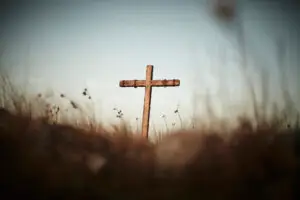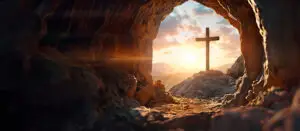This chapter begins the passion week. All the gospels condense the first three years of Jesus’ ministry into around 65% of the narrative and the last week constitutes about 35%. The 65% gives all the evidence of the legitimacy of his claims to be Messiah. The 35% culminates the most determinative event of his messianic labors. Everything drives toward that for it is the historical background, the demonstrable historical events in which occurred the truly reconciling work between God and man. This is no fiction. The suffering of the curse actually occurred in the body of Jesus on the cross. The message of the gospel in all of the theological explanations contained in the preaching and writing of the apostles was founded on the true historical manifestation of the Son of God in human nature. If the things recorded in these chapters did not occur, along with the preparatory background of the earlier chapters, Jesus is a fiction, the apostles were shrewd deceivers, and we are yet in our sins.
I. Jesus plans to execute the fulfillment of a pivotal prophecy. In doing so, he announced his person as he had forbidden his disciples to do – 21:1-5
A. Jesus sets up this event.
- He was going to Jerusalem to fulfill prophecy and this must be fulfilled also. At the beginning of his ministry he announced that the day by day interaction he would have with the people throughout his life, and the ministry that he would perform was in fulfillment of a significant prophecy about the Messiah (Luke 4:18-21). He knew he had come for the purpose to die in accord with passages like Isaiah 53, Daniel 9:24-26, and as implied in passages like Job 33:23-28; even so, the manner in which he announced his position as the King bringing salvation is prophesied (Zechariah 9:9) and to that also he must conform.
- He sent two disciples to obtain the animals consistent with the prophecy in Zechariah. Some of the prophecies about Jesus were fulfilled seemingly as matters that flowed into his life in the apparent “accidents” of human contact, and fortuitous events of a busy arduous life (Matthew 2:23; 4:12-16; 8:14-17).
- They would not have to spend time searching, for the animals would be in plain sight as soon as the entered the town of Bethphage. This probably was less than a Sabbath day’s journey from Jerusalem, a small suburb connected to the city by a road. Apparently, according to Broadus, it was on the eastern slope of the Mount of Olives and lay between Bethany and Jerusalem. They were near the town and Jesus, with an air of complete confidence and control, and with no hesitation about any apparent awkwardness involved in the command, told them to untie and take the donkey and its foal. He knew also that they would find the animals “immediately.” He also gave them instructions concerning what to say if any person questioned their action.
- Their answer was to include the words, “The Lord needs them.”
- These were people either supernaturally prepared for this moment, or were friends that Jesus had made who would understand the request immediately. (cf. Luke 19:33, 34).
- He refers to himself as the Lord, the one who needs nothing outside of himself. Isaiah said, “Have you not known? Have you not heard? The everlasting God, the Lord, the Creator of the ends of the earth, neither faints nor is weary” (Isaiah 40:28). Paul affirmed his self-existence and that he holds all things together: “And he is before all things, and in Him all things consist” (Colossians 1:17).
- He also used the words, “needs them.” We see the condescension of his humanity, putting himself into a circumstance of need in our nature. He hereby shows also, that all the things we “need” are merely temporary. The animals were needed for this one important event, and afterwards would be returned to the owners as Jesus and the disciples made their way to Bethany at the end of the day (17).
- Our needs not only are temporary, they are mean and lowly. No matter how glorious and lasting in the eyes of the world, no matter how coveted as a thing of power, prestige, or class, all will pass away and be melted with fervent heat. Nor should any possession, no matter its religious or emotional significance, become such a point of devotion that it cannot upon some occasion be forfeited. Even the ark of the covenant was lost and the stick that held the brazen serpent was destroyed as an idol (2 Kings 18:4).
B. Jesus assured the immediate conclusion of the crowd that this was his purpose, to announce publicly that their King had come (cf Luke 19(39, 40). Prior to this, he had forbidden his disciples to tell of events that had driven them to this conclusion, for they did not yet grasp its significance. He himself must do this as he moves toward his final confrontation with the false teachers of the Law. There would be no time for an organized rebellion with the expectation that he would arise as the champion of a newly liberated Israel. The kingdom would be built on his blood, not the blood of his subjects.
- The entry occurs on the day that the Passover Lamb is set aside to be offered four days later (Exodus 12:1-8). He would put an end to the symbol and the ceremony by becoming in his own body the final and only effectual sacrifice (Hebrews 9:24-28; 10:8-14 “But this man, after he had offered one sacrifice for sins forever, sat down at the right hand of God.” 1 Corinthians 5:7b- “For indeed Christ, our Passover, was sacrificed for us.”).
- Jesus chose to declare publicly his status as Messiah within the week of his coming final rejection and death. His rejection would lead then to the greatest manifestation of messianic status and purpose. (Acts 2:23).
- It occurred in conformity with a particular passage of Scripture, Zechariah 9:9. This passage called upon Jerusalem to rejoice, and acclaimed the coming one as King. It said that he is “just and having salvation,” and said that would ride into Jerusalem in a lowly manner on the foal of a donkey. According to Jewish commentators, this was viewed by them as a messianic passage and so would have been taught as such in the synagogue. This movement, therefore, was a bold and clear act on the part of Jesus, sure to identify his claims to be the one promised.
II. The execution of the Prophecy and the Response to it.
A. The disciples did as Jesus requested. They were asked by the owners of the animals what they were doing (Mark 11:5; Luke 19:33, 34). They answered as instructed, and, without any objection or hindrance, took the animals to Jesus. Surely the disciples, again, were amazed at the perfect knowledge that Jesus had of all things and the order of all events. This should have sparked within them the reality of his having told them that in Jerusalem he would be rejected and crucified. He had already done this on three occasions prior to this (Matthew 16:21; 17:22, 3; 20:17-19). Their lack of perception as well as their emotional state led them to hear very selectively.
B. As they had no donkey prior to this, because no need of it, so they had no saddle. They provided some comfort and some aplomb to this regal ride by putting their own garments on the animals. Nothing was prepared specifically for this, as it would have been on a planned entry of a king into a city of his possession. Instead they gave their own garments, they gave of themselves for this occasion.
C. Jesus sat on “them” meaning the clothes, outer garments, that they had given for the quickly developing scene. Some have sought to picture Jesus in an awkward position somehow using both animals for his ride, but Mark and Luke, and the prophecy, make it clear that Jesus rode the colt, not the mother. None had ever ridden the colt before and its first rider was the king of the Ages. In a typical act of mercy, even toward animals, Jesus had requested that the donkey be brought as well as the colt for the comfort and security of the young foal.
D. When the crowd saw this, they imitated the disciples in taking off their outer garments, strewing them along the way with palm branches. If officials and religious leaders would not give a welcome to the king, the common people certainly would see to it. They remembered the recent resuscitation of Lazarus from a four-day grave (John 12:17), and probably had expectation that something monumental was in the making. At this point it matters not that these same voices would shout for his life later. They would be stirred to that by a well-planned and sinister plot of accusation that would result in the unjust execution of this supposedly dangerous trouble-maker (John 11:48; 12:19).
E. The people shouted phrases from Psalms that were viewed, and indeed were intended, as messianic. They shouted Psalm 118:25, 26 (“Hosanna, Save now” and Psalm 148:1) Jesus quoted from Psalm 118:22, 23 later in the chapter as he revealed the heart of unfaithfulness present in the chief priests and Pharisees. In so doing, he placed himself as the one in whom the entire Psalm finds it ultimate fulfillment.
F. This entry, tantamount to an announcement that he is coming as the long-awaited Messiah, combined with the stir of excitement and contemplation arising from the living Lazarus, Matthew tells us, “the whole city was stirred up.” They wanted to know who this was. Those giving the questions were probably those who had recently come to Jerusalem from all over the country and even from foreign countries for Passover.
G. The answer they gave was, “this is the prophet Jesus, from Nazareth of Galilee.” He was at least a prophet for he fulfilled all the other prophets and was the consummate prophet. He not only spoke the words of God, but was the Word of God. He entered as a king, was confessed as a prophet, and soon would do the final work of a priest.















